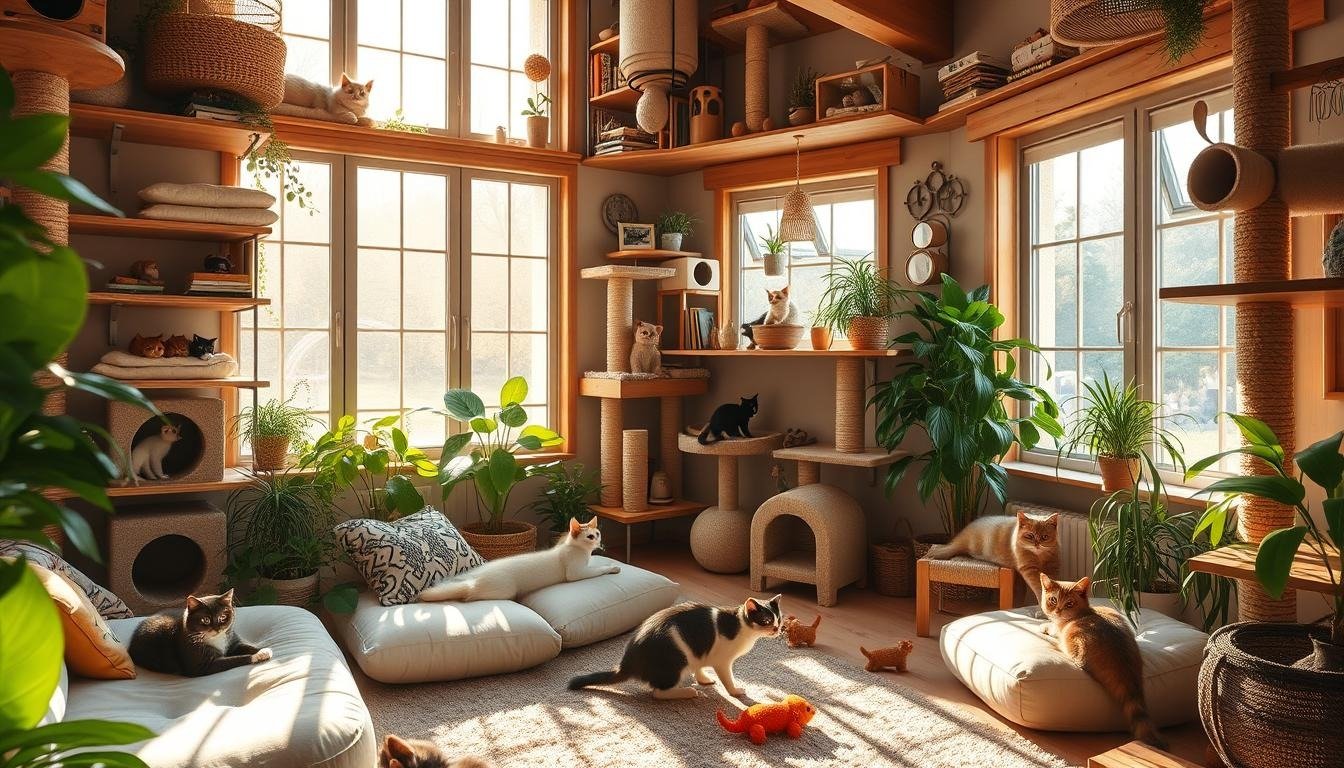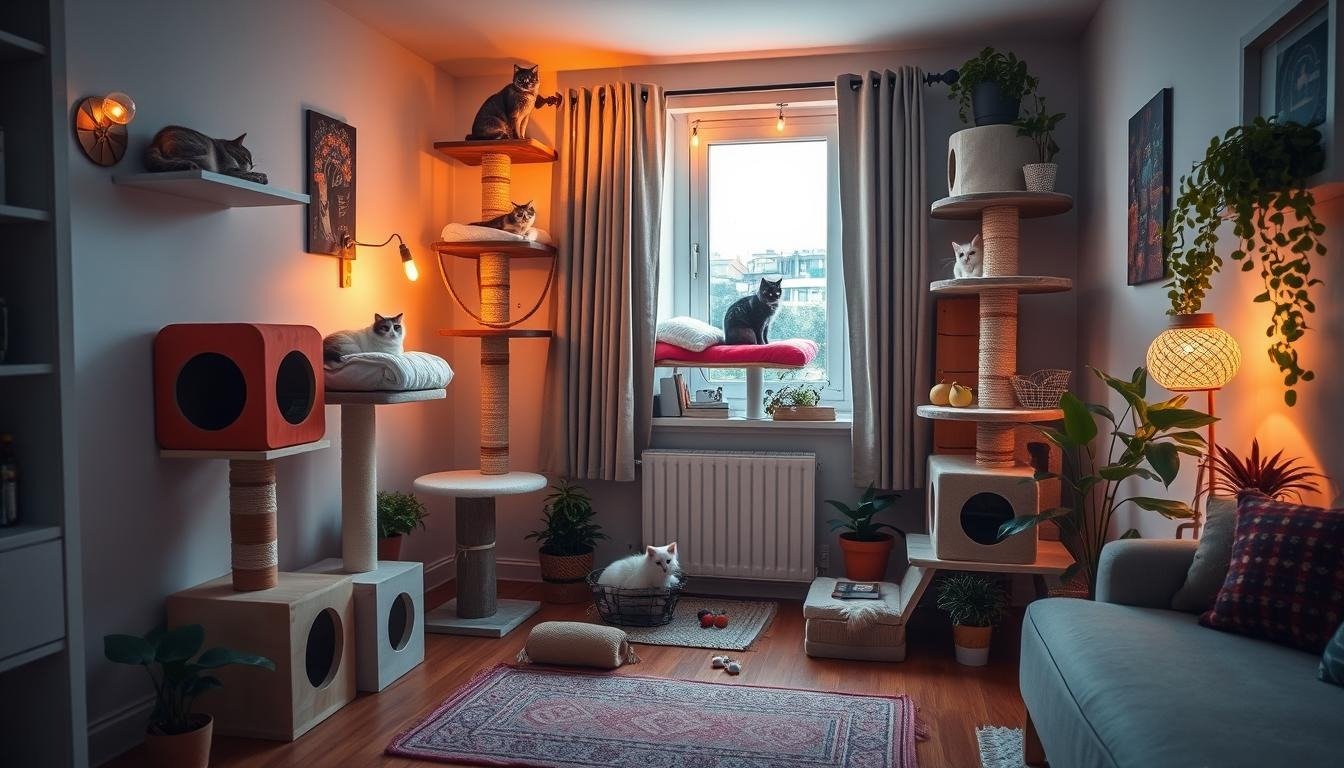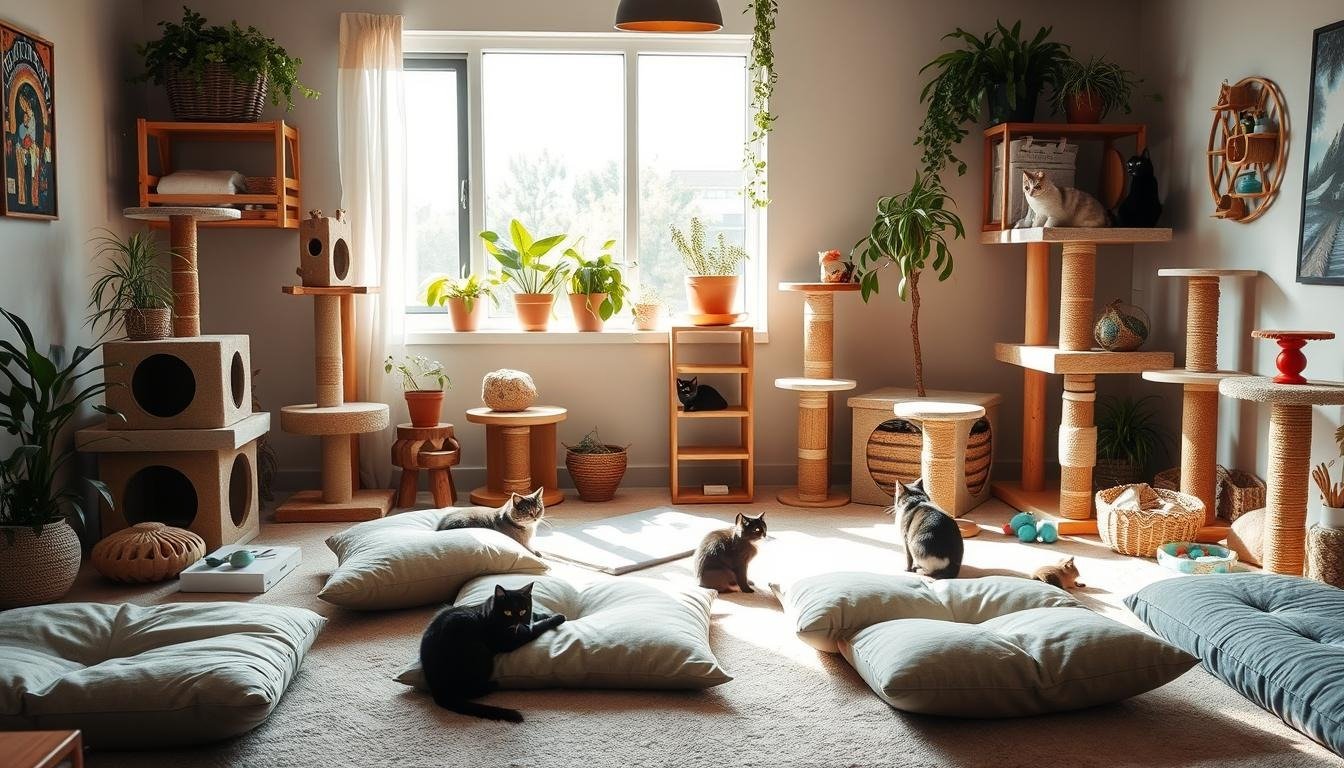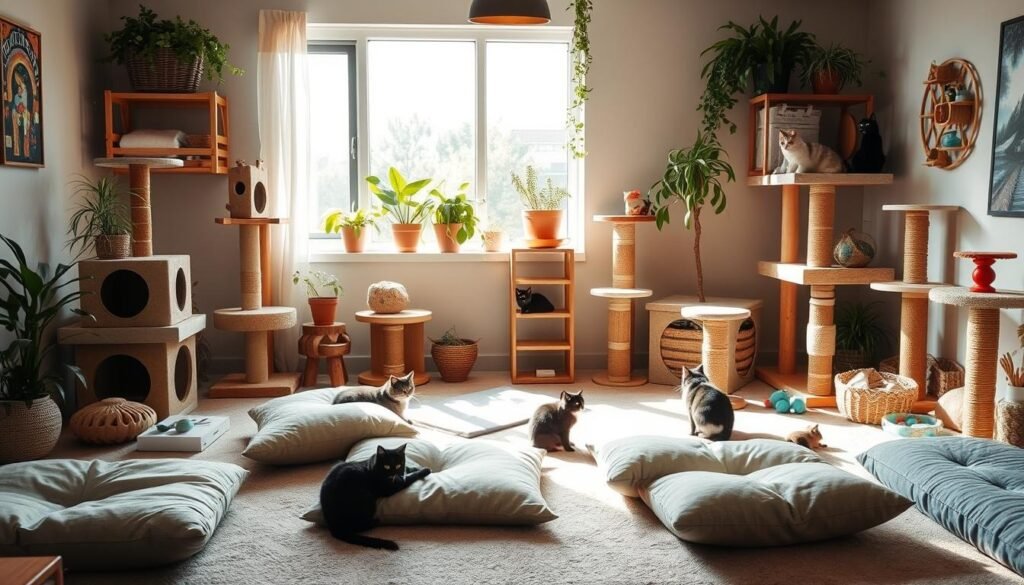As cat owners, it’s crucial to give our feline friends the right space. This is vital for their happiness and health. In this guide, we’ll explore what cats need in terms of space. We’ll share expert tips to help your cats enjoy their indoor homes.

Key Takeaways
- Understanding the basic space requirements for indoor cats, including minimum square footage and the impact of living space on their behavior.
- Exploring the importance of vertical space and the benefits of climbing structures, window perches, and optimal ceiling height.
- Considerations for multi-cat households and how to calculate the appropriate living space.
- Creating functional zones within your cat’s territory, including feeding areas, litter box placement, rest and play zones, and privacy retreats.
- Strategies for maximizing limited space in small apartments and utilizing space-saving furniture and multi-purpose cat equipment.
Understanding Basic Cat Space Requirements
Knowing how much space a cat needs is key to a happy home. The space needed can change based on if the cat stays inside or goes outside.
Indoor vs Outdoor Space Considerations
Indoor cats need more room to act like their wild selves. But, outdoor cats might need less space since they can explore outside. It’s vital for both to have enough room to play and exercise.
Minimum Square Footage Guidelines
- A single indoor cat should have at least 200 square feet of space.
- For multiple cats, add 100 square feet for each extra cat.
- Outdoor cats need at least 400 square feet of safe, fenced area.
Impact of Living Space on Cat Behavior
The size of a cat’s space affects their mood and health. Small spaces can lead to stress, like too much grooming or aggression. Giving them enough cat home size and cat room size helps them stay happy and healthy.
“Cats are very sensitive to their environment, and the amount of space they have can greatly influence their physical and mental health.”
By knowing what space cats need, we can make their homes better. This way, our feline friends can live their best lives.
How Much Space Do My Cats Need: Essential Factors
Finding the right space for your cats is key to their happiness and health. Several important factors affect how much space cats need. These include their age, breed, personality, and how active they are.
Kittens and young cats need lots of space because they are full of energy. They love to explore, play, and climb. Older or less active cats might be okay with a smaller space, as long as they have what they need.
The size of your cat’s breed also matters. For example, larger breeds like Maine Coons or Norwegian Forest Cats need more cat housing and cat square footage. Smaller breeds, like Siamese or Ragdolls, might need less.
A cat’s personality is also important. Shy or anxious cats prefer a cozy, private spot. Social, outgoing cats do well in open, interactive spaces.
Lastly, a cat’s activity level is crucial. Cats that love to climb, jump, and play need lots of space. They need both vertical and horizontal room to be happy.
“The key is to provide your cats with a comfortable, enriched environment that meets their physical and mental needs, regardless of the available cat housing or cat square footage.”
By thinking about these factors, you can make a home that’s perfect for your cat. It will be a place where they can be happy, healthy, and fulfilled.
Vertical Space: Why Height Matters for Cats
Vertical space is key for a comfy cat living area. Cats love to climb and explore from high spots. By adding height, you meet their physical and mental needs.
Climbing Structures and Cat Trees
Sturdy cat trees are great for vertical space. They let cats climb, scratch, and rest high up. This meets their natural behaviors and makes playtime fun.
Window Perches and Shelving Systems
Window perches and shelves are great for using vertical space. They let cats see outside and get sunlight. This makes their space more fun and interesting.
Optimal Ceiling Height Requirements
The ceiling height is very important for your cat living area. It should be at least 8 feet high for climbing. Taller ceilings make the space feel bigger and give cats more room to move.
“Vertical space is essential for cats, as it allows them to fulfill their natural instincts to climb, perch, and survey their territory. By incorporating ample vertical elements into your cat’s living area, you can create a stimulating and enriching environment that supports their overall well-being.”
Multiple Cat Households: Space Calculations
When you have more than one cat, knowing how much space they need is key. It’s not just about the square footage of your home. It’s about making a peaceful place for them to live.
When figuring out space for multiple cats, think about a few things. Each cat needs its own food, water, litter box, and place to rest. This helps avoid fights and keeps them calm. Aim for at least 18 square feet per cat, plus more for shared areas and climbing spots.
| Number of Cats | Minimum Recommended Space |
|---|---|
| 1 cat | 18 sq ft |
| 2 cats | 36 sq ft |
| 3 cats | 54 sq ft |
| 4 cats | 72 sq ft |
Remember, these are just the basics. Your cats might need more space based on their personalities and how active they are. Adding cat trees and shelves can also make them happy by letting them climb and explore.
Think about how much space do my cats need and design a cat home size that fits their needs. This way, you can make a happy and fulfilling home for your cats.
“Creating the right living space for multiple cats is essential for their physical and mental well-being. Investing in the right amount of space can lead to a happier, healthier, and more content feline family.”
Creating Functional Zones in Your Cat’s Territory

Creating a cozy and fun space for your cat needs careful thought. You must consider their natural behaviors and needs. It’s important to set up different areas for their activities and likes.
Feeding Areas and Litter Box Placement
Cats are very particular about where they eat and go to the bathroom. It’s best to put these spots in quiet, low-traffic areas of your home. This keeps them safe and calm.
Rest and Play Zones
Cats like to switch between resting and playing. Having special places for both can make them happier. Set up a cozy bed or perch for resting and a play area with toys and scratching posts for fun.
Privacy Retreats
Cats love their alone time and a quiet place to hide. Add small, hidden spots like a cat condo or a cozy nook. These places help them escape the daily noise and stress.
By setting up these zones, you meet your cat’s cat room size and cat housing needs. This makes them happy and healthy, living a full and joyful life.
Small Apartment Solutions for Cat Owners
Living in a small apartment doesn’t mean you can’t give your cats a great place to live. With a little creativity, you can make the most of the cat square footage and ensure your cats have plenty of cat living area.
Using vertical space is a smart move. Cat trees, wall-mounted shelves, and window perches are great. They let cats climb and explore while saving floor space for other important things.
- Invest in a modular cat tree that can be customized to fit your apartment’s unique layout.
- Utilize wall-mounted shelves and ledges to create a multi-level cat playground.
- Strategically place window perches to allow your cats to enjoy natural sunlight and bird-watching.
Another smart idea is to choose furniture that’s good for cats. For example, a coffee table with a hidden litter box or a couch with built-in scratching posts. This way, you can make the most of your small space.
“With a little ingenuity, small-space living can be transformed into a feline paradise.”
By using these creative ideas, cat owners in small apartments can give their pets the cat square footage and cat living area they need. This ensures a happy and content home for everyone.
Maximizing Limited Space for Indoor Cats
Living in small apartments or homes means you need to make the most of your space for your cats. You can do this with smart furniture and multi-use cat gear. This way, you can make a cozy and fun space for your cats, even in tight spots.
Space-Saving Furniture Ideas
Choosing furniture that saves space is key. Wall-mounted cat shelves are great because they use vertical space without taking up floor room. Also, foldable cat trees or scratching posts are perfect for small homes because they can be tucked away when not needed.
Multi-Purpose Cat Equipment
Look for cat furniture and accessories that do more than one thing. For example, a cat tower with storage can be a stylish spot for your cat to play and a place to store things. A cat bed that can be used for sleeping or scratching also helps keep your space tidy and makes the most of your cat home size.
“By thoughtfully selecting multi-purpose cat furniture and incorporating vertical space, you can create a comfortable and visually appealing environment for your indoor cats, even in limited living quarters.”
To successfully use cat space requirements in small homes, focus on versatility, storage, and using vertical space. With a bit of creativity and planning, you can turn your home into a happy place for your cats.
Signs Your Cat Needs More Space

Cats are known for their independent nature. But even the most self-sufficient feline companions can sometimes feel the need for more living space. As responsible pet owners, it’s essential to recognize the signs that your cat may be craving a bit more room to roam. By understanding these key indicators, you can take proactive steps to ensure your furry friend’s comfort and well-being.
One of the most obvious signs that your cat needs more space is a change in their behavior. If your once playful and curious kitty has become more reclusive, hiding away for extended periods, it could be a sign that their current living environment is feeling too confined. Also, an increase in destructive behaviors, such as scratching furniture or excessive meowing, may suggest a need for more stimulation and exploration opportunities.
- Increased stress and anxiety, as manifested through excessive grooming, poor appetite, or excessive vocalization
- Lack of physical activity, with your cat spending more time napping or sleeping rather than engaging in their usual playtime and exercise
- Territorial marking, such as spraying or urinating outside the litter box, which can be a response to feeling confined or insecure in their environment
If you notice any of these cat room size warning signs, it may be time to reevaluate the available how much space do my cats need in your home. By providing your feline companion with the appropriate amount of space, both horizontally and vertically, you can help alleviate their stress and promote a happier, healthier lifestyle.
Every cat is different, needing various amounts of space. This depends on their age, breed, and personality. By watching your cat’s behavior and creating a cozy, engaging environment, you can ensure they have the space to thrive.
Conclusion
Knowing how much space a cat needs is crucial for cat owners. This article discussed what makes a good home for cats. It covered indoor vs. outdoor space, the right square footage, and how space impacts cat behavior.
It’s important to give cats enough vertical space. This includes climbing structures, window perches, and high ceilings. For homes with more than one cat, it’s key to ensure each cat has enough room.
Whether you live in a small apartment or a big house, you can make the most of your space. Create special areas for your cat, like places to eat, sleep, and play. By understanding what your cat needs, you can create a happy and fulfilling home for them.
FAQ
How much space do indoor cats need?
Indoor cats need at least 200 square feet of space. But, the exact amount depends on the cat’s age, breed, and activity level. It also depends on if there are other cats in the house.
What is the ideal square footage for a cat’s living area?
The best space for a cat is between 400 to 600 square feet. This size lets cats play, climb, and rest comfortably. It helps them stay healthy and stress-free.
How does the number of cats in a household affect the required living space?
If you have more than one cat, you’ll need more space. Add 200 square feet for each extra cat. This ensures each cat has enough room and resources to live peacefully together.
What are the essential factors that determine a cat’s space requirements?
Several things affect how much space a cat needs. These include the cat’s age, breed, personality, and activity level. Kittens, older cats, and very active breeds need more room than calm, adult cats.
How important is vertical space for cats?
Vertical space is very important for cats. They love to climb and have places to rest high up. Providing enough vertical space lets them hunt, play, and rest naturally.
What are some space-saving solutions for cat owners in small apartments?
For those living in small apartments, there are ways to save space. Use multi-level cat trees, wall shelves, and compact cat furniture. These options make the most of your space while keeping your cat happy and comfortable.
How can I tell if my cat needs more living space?
If your cat seems stressed or uncomfortable, they might need more space. Look for signs like too much grooming, aggression, or accidents outside the litter box. Also, watch for physical signs of restlessness. If you notice these changes, your cat might need a bigger area to live in.
